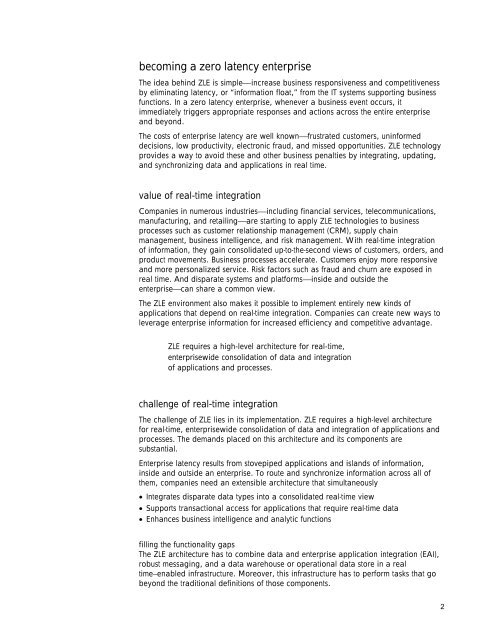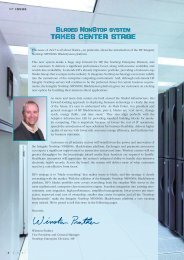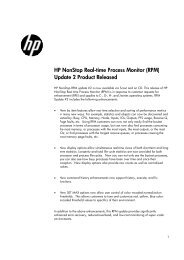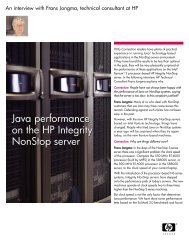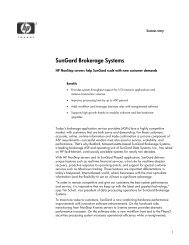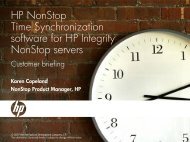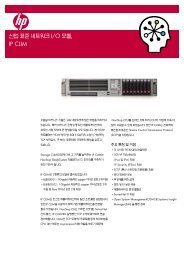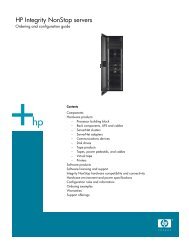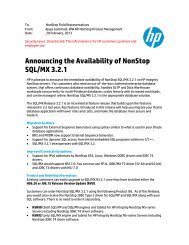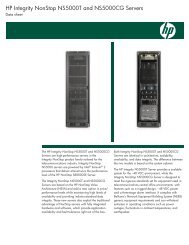the business case for a zero latency enterprise - HP NonStop
the business case for a zero latency enterprise - HP NonStop
the business case for a zero latency enterprise - HP NonStop
You also want an ePaper? Increase the reach of your titles
YUMPU automatically turns print PDFs into web optimized ePapers that Google loves.
ecoming a <strong>zero</strong> <strong>latency</strong> <strong>enterprise</strong>The idea behind ZLE is simple⎯increase <strong>business</strong> responsiveness and competitivenessby eliminating <strong>latency</strong>, or “in<strong>for</strong>mation float,” from <strong>the</strong> IT systems supporting <strong>business</strong>functions. In a <strong>zero</strong> <strong>latency</strong> <strong>enterprise</strong>, whenever a <strong>business</strong> event occurs, itimmediately triggers appropriate responses and actions across <strong>the</strong> entire <strong>enterprise</strong>and beyond.The costs of <strong>enterprise</strong> <strong>latency</strong> are well known⎯frustrated customers, unin<strong>for</strong>meddecisions, low productivity, electronic fraud, and missed opportunities. ZLE technologyprovides a way to avoid <strong>the</strong>se and o<strong>the</strong>r <strong>business</strong> penalties by integrating, updating,and synchronizing data and applications in real time.value of real-time integrationCompanies in numerous industries⎯including financial services, telecommunications,manufacturing, and retailing⎯are starting to apply ZLE technologies to <strong>business</strong>processes such as customer relationship management (CRM), supply chainmanagement, <strong>business</strong> intelligence, and risk management. With real-time integrationof in<strong>for</strong>mation, <strong>the</strong>y gain consolidated up-to-<strong>the</strong>-second views of customers, orders, andproduct movements. Business processes accelerate. Customers enjoy more responsiveand more personalized service. Risk factors such as fraud and churn are exposed inreal time. And disparate systems and plat<strong>for</strong>ms⎯inside and outside <strong>the</strong><strong>enterprise</strong>⎯can share a common view.The ZLE environment also makes it possible to implement entirely new kinds ofapplications that depend on real-time integration. Companies can create new ways toleverage <strong>enterprise</strong> in<strong>for</strong>mation <strong>for</strong> increased efficiency and competitive advantage.ZLE requires a high-level architecture <strong>for</strong> real-time,<strong>enterprise</strong>wide consolidation of data and integrationof applications and processes.challenge of real-time integrationThe challenge of ZLE lies in its implementation. ZLE requires a high-level architecture<strong>for</strong> real-time, <strong>enterprise</strong>wide consolidation of data and integration of applications andprocesses. The demands placed on this architecture and its components aresubstantial.Enterprise <strong>latency</strong> results from stovepiped applications and islands of in<strong>for</strong>mation,inside and outside an <strong>enterprise</strong>. To route and synchronize in<strong>for</strong>mation across all of<strong>the</strong>m, companies need an extensible architecture that simultaneously• Integrates disparate data types into a consolidated real-time view• Supports transactional access <strong>for</strong> applications that require real-time data• Enhances <strong>business</strong> intelligence and analytic functionsfilling <strong>the</strong> functionality gapsThe ZLE architecture has to combine data and <strong>enterprise</strong> application integration (EAI),robust messaging, and a data warehouse or operational data store in a realtime−enabled infrastructure. Moreover, this infrastructure has to per<strong>for</strong>m tasks that gobeyond <strong>the</strong> traditional definitions of those components.2


